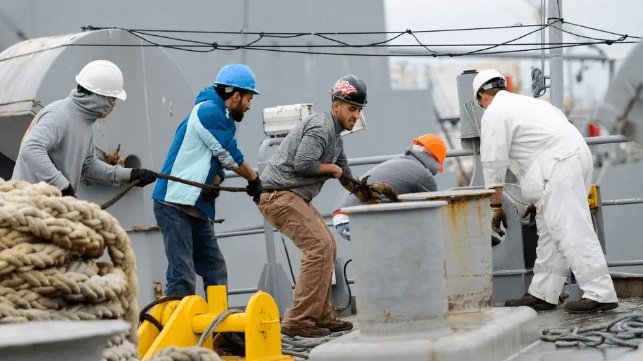U.S. May Not Have Enough Mariners Available to Mobilize Sealift Fleet
"I am not confident that all of those ships would be manned," warns MARAD chief RAdm Ann Phillips

The readiness of U.S. sealift capability has been in decline for years, but it is beginning to reach a critical point, U.S. Maritime Administrator Rear Adm. Ann Phillips (USN, ret'd) told a House subcommittee meeting on Tuesday. According to Phillips, MARAD's Ready Reserve Force (RRF) fleet is down to 45 ships, with an average age over 45; not all of them run reliably; commercial drydock space to get necessary work done is getting scarce; and even if every vessel were in a good state of repair, there may not be enough qualified mariners left to man the full fleet.
"I am not confident that all of those ships would be manned, I think I should be extremely straightforward there," she told the subcommittee. "We know that we have a mariner shortfall. The last numbers we have predate COVID, and they estimate 1,800 [mariners available] . . . And the Ready Reserve are aging vessels, which means that there are skillsets required to run them [like steam] that not a lot of mariners have. One of our problems is figuring out who we have, what qualifications do they have, and will they sail."
"I think everybody here should find that incredibly alarming. That is a red star cluster," said Rep. Michael Waltz, chairman of the House Armed Services Readiness subcommittee. "We've gone from 400 ships in the First Gulf War down to 40, and we can't even staff the 40."
The task of finding, training and retaining more deep-sea mariners is a challenging issue for government and private industry, given the long decline of the U.S. deep-sea fleet, Phillips noted. Among other attempts to stem the slide, MARAD has launched a "centers of excellence" program to recognize quality training institutions; set up counter-sexual assault measures to make the industry more appealing to female entrants; and invested more funding in the U.S. Merchant Marine Academy, the primary source of MARAD's officer pool for the Ready Reserve.
Shipyard availability is an equally thorny challenge, as multiple agencies need the same drydocks. "As we work to maintain the Ready Reserve Force and build new vessels, we struggle with enough capacity within the country," said Phillips. "Active duty military, Ready Reserve and Military Sealift Command, Coast Guard, Army Corps, we're all fighting and struggling for the same drydock capacity, which is very limited. . . . Additional capacity in maintenance and construction is an urgent need in order to maintain a ready force here."
To get at the problem of fleet renewal without the cost and availability questions of building in the U.S., MARAD has returned to an approach it used in the Cold War era - buying used foreign-built tonnage. Two commercial ro/ro ships, ex names Honor and Freedom, have been purchased and will join the Ready Reserve this summer.
"It's very important that we maintain readiness, which is why we need to maintain the [RRF] recapitalization rate so that we can get the readiness back and gain the capacity back," emphasized General Jacqueline D. Van Ovost (USAF), head of United States Transportation Command, which uses the sealift fleet in time of war.
